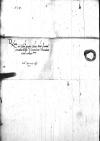Non habeo plane, quod ⌊hinc⌋ scribam Dominationi Vestrae Reverendissimae, segregatus a curia. Nam propter pestem varie nunc dispersi sumus, alii alio commigrarunt. ⌊Rex⌋ etiam excedens ⌊Cracovia⌋ per pagos vicosque vagatur, non nisi cum ⌊ambobus cancellariis⌋ et cum uno ⌊palatino Sandomiriensi⌋. Aulicos etiam a ⌊se⌋ ablegat et in ⌊Russiam⌋ militatum mittit cum nonnulla manu stipendiariorum aere suo privato conductorum, cum nos ⌊subditi⌋ iuvare illum contributione noluimus.
Ego ⌊Cracoviae⌋ ago securus et sperans in Deo cum ceteris ⌊canonicis⌋, nam lues haec non nisi in xenodochiis regnat et kucharcas, scholares, babas on the margin⌈babasbabas on the margin⌉, mendicos tollit. ⌊Domina nostra⌋ de peste hac maiora veris narrare iubet et metum auget, ut seniculum ⌊regem⌋ extra ⌊Cracoviam⌋ teneat ac vertet hinc inde, ut scilicet vitam ei producat vectatione, cantu, choreis et id genus frascariis charitiis[1] vel, ut homines dicunt, ut senem alibi quam Cracoviae morti proximae obiciat. Suum hic agit negotium, ut thesauros et res suas omnes, quas sub colore pestis, etiam longe antea, quam pestis suspicio ulla esset, ⌊Cracovia⌋ extulit, salvas retineat. ⌊Cracoviam⌋ fugitat, ne in morte ⌊senis⌋ Cracoviae cum rebus concludatur. Timet ⌊episcopum⌋, ⌊palatinum⌋, ⌊castellanum⌋ Cracovien(sem) or Cracovien(ses)⌈Cracovien(sem)Cracovien(sem) or Cracovien(ses)⌉, ⌊regi filio⌋ non fidit. Nollet quidquam ex divitiis suis amittere. Plerique ad fugam eam spectare arbitrantur, ex eo maxime, quod sub fines ⌊Regni⌋ vagetur, quo facilior sit rerum exportatio. Miseri divites! Quantis sceleribus divitias parant, quantis curis servant, quanto metu, ne amittant, discruciantur! Miseret me ⌊dominae⌋, cui uti servus omnia debeo. Cupio ⌊illam⌋ hoc metu liberari. Non cadet ⌊ei⌋ capillus de capite manenti apud nos in ⌊Regno⌋ suo. Numquam enim ⌊Polona gens⌋ tanta se turpi<tu>dine coninquinavit.
Dominatio Vestra Reverendissima epistulam hanc concerpat nec istas frascas quisquam sciat, quas confidenter ei scribo.
 BCz, 247, p. 420
BCz, 247, p. 420
Non est adhuc tanta pestis ⌊hic⌋, uti fertur. Sunt quidem aegritudines acutissimae ac violentae, quae dispositos ad hanc luem subito necant. Multi tamen homines stain⌈[es]es stain⌉ ⌊Cracovia⌋ discesserunt. Omnes maledicunt ⌊reginae⌋, quae fuga et praedicatione pestilentiam disseminavit etc. Quam Dominus Deus a nobis ac a populo Christiano procul avertat.
Nova dominus ⌊Mauritius⌋, quae audivit, quae vidit, dicet, praecipue de ⌊caesare Catholico⌋. De ⌊Turcico⌋ vero mercatores nostri dicunt cum maxima potentia adventare illum ad ⌊Transilvaniam⌋, quam ⌊rex Ferdinandus⌋ prodit perditque. Hac enim condicione pacem seu indutias cum ⌊Turco⌋ fertur on the margin⌈ferturfertur on the margin⌉ fecisse written over t⌈tssesse written over t⌉, ut omnia, quae in manibus ⌊Ferdinandi⌋ sunt, ea tuto retineat. ⌊Transilvaniam⌋ autem in manibus ⌊eius⌋ non fuisse. Hae igitur indutiae, haec pax potissimam ⌊Hungariae⌋ partem perdet. Utinam haec vera non sint.
Quod autem Dominatio Vestra Reverendissima tam humaniter ad me ⌊⌋ dignatur et ad amicitiam recipit, ago illi hoc nomine maximas gratias hidden by binding⌈[s]s hidden by binding⌉ et hanc tantam illius in me propensionem perpetuis obsequiis meis promereri written over e⌈eii written over e⌉ curabo. Cui me humiliter commendo et ut salva, felix ac laeta quam diutissime vivat, ex animo precor.



 BCz, 247, p. 422
BCz, 247, p. 422